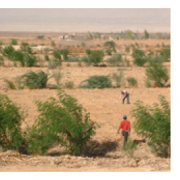Tackling Poor Access to Farm Extension Services with ICTs
Poor access to farm extension services is still a major impediment to agricultural productivity and the improvement of rural livelihoods. But, increasingly, ICTs are playing a central role in enabling and facilitating the provision of demand-driven extension services. This marks a shift from highly inefficient public sector extension delivery models, under which farmers and rural communities had little/no opportunity to articulate their own needs.
Despite the ICT-enabled shift towards more democratic/pluralistic, demand driven and efficient extension services in some places, there is still a far way to go before game changing impacts are made.
Although the use of conventional technologies such as radio and television, and even new ICTs, is commendable, many “model projects” reach too few people and are unsustainable.
But the emergence of multiple players in the evolving extension services landscape—NGOs/CBOs, private sector actors, and farmers as extension service users and sharpers, among others—presents broad opportunities. The main opportunity I foresee is that of a firmer platform for articulating the need for better telecommunications policies, which will benefit extension services and the broader range of development objectives that hinge on access to ICTs.
Consequently, agricultural planners and policy-makers ought not to be particularly concerned with specifically enabling the integration of ICTs into pro-poor extension service delivery. While that is a desirable objective, it ignores the broader picture—poverty reduction.
Strategic agricultural planning recognize that ICT-based solutions for agricultural problems are not all sector specific. In much the same way that the major agricultural challenges operate on a macro-level, by cutting-across sectors, the solutions must stem from holistic observations and responses.
Indeed, any ICT intervention that improves the livelihoods of the rural poor is likely to have positive (direct and indirect) impacts on agricultural value chain management—planning, productivity, and marketing. This is true to the extent that rural economies are largely agrarian. So, any challenge to improving the general livelihood of the rural poor will adversely affect agricultural productivity— be that challenge inadequate health services, poor resource management, natural disasters, anthropogenic shocks, minimal access to education, financial services and poor infrastructure, etc.
So, strengthening extension services will require tackling more systemic problems… seeing the forest and not just the trees.






































